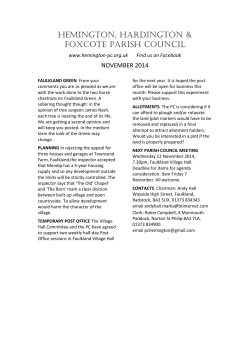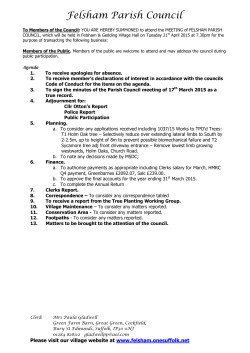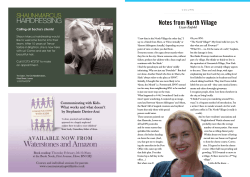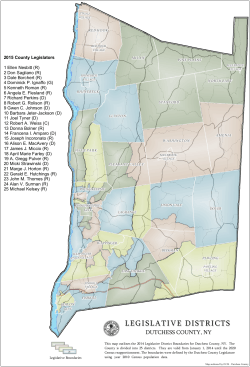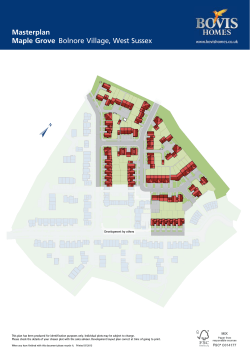
Hook Norton Village Trail
Hook Norton Village Trail Hook Norton is a large village lying eight miles SW of its traditional market town, Banbury, and five miles NE of Chipping Norton. In 1971 its population was 1361, in 2000 it was 2051. The parish of Hook Norton is one of the largest in the county, covering 5340 acres of undulating countryside, varying between 450 and 650 ft above sea level and lying on the boundary of the famous N Oxfordshire redlands and the oolitic limestone belt to the SW. It has been, and remains, mixed farming country. Settlement is concentrated in the village of Hook Norton itself. 'Hocneratune' is first mentioned in 917, when the Anglo-Saxon Chronicle tells us that a battle between the Saxons and the Danes took place nearby. The name of Saxon origin, meaning 'the village on the hill slope of Hocca'. The village's situation on the slopes of the steep-sided stream valley has continued to mould its long and straggling settlement pattern. In the Middle Ages the village was divided between two main manors, one owned by Robert d'Oilly and his successors, the other by the Abbey of Osney. This pattern of landholding broke up in the early 16th Century and Hook Norton has not been a village dominated by a particular big house or estate since. The village has always lain away from major transport routes and has developed a distinctive and independent identity of its own. Visually it retains the character of an ironstone village with many buildings dating from its period of prosperity in the 17th and 18th Centuries. The community has always been dominated by agriculture and its associated trades. Only the development of ironstone working (1889 to c.1926) and the village's famous brewery have varied patterns of employment. A major change in the modern village has been that where in the 19th and early 20th Centuries contraction in agriculture meant that the only solution for many villagers was emigration, now cars and buses enable an increasing number of people to live in Hook Norton and work elsewhere. Hook Norton is once again a growing village, as new housing developments show. The aim of this trail is to help its readers appreciate the history and present day character of the village by pointing out the many varied clues to the past that can be seen on a walk in the village. Suggested stopping points are indicated by the numbers in the text and on the map in the middle of this booklet. This booklet has been prepared by the Hook Norton Parish Survey Group, based on a Hook Norton Evening Centre Class run in conjunction with Oxford University Department for External Studies and updated in 2000. 1 1 The Parish Church of St. Peter lies right at the centre of the village and provides a convenient and historically appropriate point to begin a tour of Hook Norton. It is a large church which dominates the village visually from many viewpoints, as will be seen around the trail. Apart from its spiritual influence the Church, as an important landowner, and through the parish organisation has played a central role in the economy and government of the community. Many physical clues of this can be seen. Stand facing the S side of the church and you will see the Norman chancel, the oldest standing building in the village. The difference in style between the chancel and the body of the church is very marked. The church, rectory and lands in Hook Norton were given by Robert d'Oilly, Baron of Hook Norton to Osney Abbey, near Oxford, in 1129. This link lasted until the dissolution of the abbey in 1539, during which time it was responsible for the chancel of the church. This is why the chancel is strikingly plain and largely unaltered, whilst the rest of the church was gradually rebuilt and enlarged. A clue to one change can, however, be seen from the S. The original pilaster buttresses do not reach to the roof of the chancel, showing how the roof was raised to accommodate the 14th Century E window, with its flamboyant, flowing tracery in the Decorated style. The Norman church was large and Cruciform. In the inside E wall of the N transept a fragment of an Original Norman archway can be seen. During repairs to the inside of the chancel in 1981, several further openings and archways were discovered in the original masonry and are being studied by church archaeologists. 2 The church was altered by the addition of aisles, first on the N in c. 1300 and then on the S, with the 14th Century aisle and transept in the Decorated style. During the 15th Century the Perpendicular clerestory, chancel arch and substantial, pinnacled W tower were added. You can clearly see these phases of building inside the church. 2 As you enter the church notice the attractively crude, locally made hinges of the S door, complete with the names of the churchwardens of 1739. In the SW corner of the church stands an important example of a Norman tub font, decorated with carvings of a fascinating mixture of the biblical and the pagan. Adam and Eve, Sagittarius and Aquarius are amongst the figures, as you see from the cover of this booklet. Notice also the window over the chancel arch, a distinctive feature of major Cotswold churches, here echoed on the western fringes of the area. Below this is a 15th Century wall painting depicting SS Peter and Paul which would have backed the Rood and its screen, removed in the 19th Century when this church, like so many others, underwent restoration and 'improvement'. Another wall painting appears over the S nave arcade. On the N arcade is a wall tablet commemorating a son of Hook Norton who died in Valparaiso, Indiana, not so surprising in view of the many villagers who emigrated, often to America or Canada, during periods of agricultural depression in the 19th and 20th Centuries. Tucked away in the corner of the N transept is a grave slab bearing an inscription to Isabel de Plesset, widow of a 13th Century lord of Hook Norton, successor to the d'Oillys. This is the oldest memorial in the church, and has the indent of a later brass. In the N aisle is a range of objects indicating the parish's role, which lasted from the 16th to the early 19th Century, in running village affairs. The parish chest, roughly carved with the date 1727, contained the main records of the community, including the registers of baptisms, marriages and burials, the administration of the poor law, the highways and constables' books. Nearby is the scarlet and blue 18th Century fire engine, whilst using the parish thatch hook to drag down burning thatch from roof level, was certainly a matter of communal effort, as anyone testing its weight will discover. 3 The churchyard offers much fascinating information, like the memorials in the church, about the families of Hook Norton and many family names recur over the centuries, like Goffe, Lampett, and Austin, appear here. Like the church and characteristic buildings of the village, the stones are mainly of the rich orange-red local ironstone. 3 An unusual feature is a second burial ground beyond the wall to the N of the church. This belongs to the Baptist Chapel (see No. 11). A line of splendid elm trees ran by the wall until very recently. They, like many other elms in the parish, had to be felled because of Dutch Elm Disease. This has meant considerable change to the landscape. Return to the top of the church steps, with a good view over the market place. Although Hook Norton was a large village it never developed into a market town, despite the fact that in 1437 the Earl of Suffolk, then Lord of the Manor, had a Charter to hold a market and two fairs. The established market towns of the area remained Banbury and Chipping Norton. Hook Norton's development has also been effected by its location off all important road routes. It has developed its own wide range of crafts and trades. In 1871 there were no fewer than 133 crafts and tradesmen in the village. One of these was John Borsberry, whose family ran a smithy (3a) in the brick building between The Sun and the dormer-windowed cottages to your left. In front of these (on the site of the bus shelter) was a lamp room (3b) for keeping the oil and, in summer, the actual street lights used early this century. Fairs and stock sales were held in the market square and some villagers still remember the Club Day fairs with swing boats, pony and later steam roundabouts, held here each year on the Tuesday before Whitsun. Directly opposite is an excellent example of Hook Norton's characteristic vernacular building. This is Reeve's House (3c), a 16th Century house with a steeply pitched thatched roof, coursed rubble ironstone walls, irregularly placed windows with wooden lintels and casement openings, and very substantial stone quoins and base. This numerous and thoroughly local style of building epitomises the village's prosperity in the 16th and 17th Century. It contrasts with the 'polite’ outside influenced style of the house to its right with hipped roof, symmetrically placed sash windows and dressed stone, and the revived vernacular of its neighbour with synthetic stone slate roof and restored, wooden framed windows. 4 Walk down Bridge Hill from the Market Square (passing in front of the dormer- windowed cottages and taking the path to the right in front of the garage). Pause at the little green at the foot of the hill. Although the stream appears small and the layout of the houses random we get a first indication of the steepness of the valley and the way in which the settlement follows it, producing a long, linear village. Hook Norton consisted of twin settlements, either side of the valley. As you cross the stream you enter Southrop (meaning S farm or hamlet), first mentioned in 1316. The large fronted house facing the stream is Bridge House (4a), the main premises of the private lunatic asylum, which operated from c. 1725 - 1854. The premises were specially converted with a padded cell and separate gardens for male and female inmates. 4 One of the four village tites was at the bottom of Middle Hill (4b). This was a place where water collected naturally and the tites were the main source of water supply for those villagers who did not have their own wells. Household water was fetched in buckets on a yoke. Mains water came to Hook Norton in 1955, and sewerage in 1965. Turn left over the bridge and up Park Road. Two of the cottages on your left were known as The Barracks' (4c), in the early 1900's the base of two young Salvation Army women. The next house, Windrush, used to be the home of Mr. Wyton, one of two carriers in the village. He operated between here and Banbury, a three or four hour journey, and would fetch all kinds of shopping for villagers, including clothes and shoes on approval. His horses also drew the village fire engine and grazed below the house (4d). Bear right into Rope Way. On the corner you pass the site of the Roman Catholic chapel built in 1930 and demolished in 1999. Rope Way is one of the interesting street names of the village recalling another craft. The long straight area needed for twisting and drying the ropes is thought to have run along the pathway on the right. Turn right at the corner as far as Southrop Green by the crossroads. 5 You are now standing outside Wheatsheaf House (5a) once the Wheatsheaf pub, and before that the Fleur de Lys. The inhabitants of Southrop came here for water as well as alcoholic refreshment for there was a tite on the nearby Green. The two interesting thatched cottages (5b) on the far side of the Green have all the marks of having started as squatters' dwellings on common land. 5 Looking away to your left the great piers of the viaduct (5c) which carried the Banbury to Cheltenham Railway can be seen. Hook Norton's connection with the railway came very late. The line was opened in 1887 and closed in 1962. There had been plans for such a line since 1845 but the technical problems and cost of overcoming the terrain at Hook Norton meant that nothing came of them until the section you see now was completed. The two sections of viaduct and tunnel are said to have taken 400 men four years to build, and six workmen were killed. The impact of the railway on the village was enormous, chiefly because it made the low grade ironstone of the area a commercial proposition with direct access to the lines to S Wales and Staffordshire. One of the three main companies to work ironstone operated to the SE of the village. The Earl of Dudley's Hook Norton Quarry Company dug ironstone from outcrops on the valley side (5d). This was processed in a kiln, looking rather like a blast furnace, near the viaduct and hauled up a cable-worked incline to the railway above. 6 Walk straight on at the crossroads, and then notice a substantial stone built house on your left. This is Southrop House (6a), one of the principle farm houses of the village. A drain water head on the double-gabled frontage shows a date of 1707, but the wing to the right is clearly of earlier date. It seems the 'new' house was built, leaving the 17th Century section to become kitchen and service rooms. The gateway to the left of Southrop House leads to the site of the Friends Meeting House (6b), built in 1705 and demolished in 1963. North Oxfordshire was a stronghold of the Quakers in the 17th Century. 6 7 At the next road-junction bear left into Burycroft Lane. This quiet country lane gives a panoramic view of the village on the right, emphasising how it follows the long line of the stream valley, along the far crest of which can be seen the church, the Baptist chapel (11 a) (early baptisms are believed to have taken place in the stream) and The Manor House of 1636 (10c). The name of the lane probably refers to the croft belonging to the Manor, but has become Betty Craft Lane to some villagers. By the copse look left to see the curved pattern of ridge and furrow in the fields on the hill. This has the characteristic curve produced by ploughing the old open fields with teams of oxen in the long narrow strips that denoted separate land holdings. Notice the later hedges cutting across the ridge and furrow and which are chiefly the result of the Enclosure of 1774. Turn right at the signpost back towards the village. 8 From the bridge you look across to Brooklyn (8a). With its symmetrical facade, shallow pitched and slated roof, this is the sort of farm house built when new consolidated farms were formed by enclosure. Several of these, like Gibraltar and Belleisle Farms with names recalling British feats of arms of the time, were built outside the village, unlike older farms with buildings in the centre. Just by the bridge opposite Brooklyn lies Wheelwright's Cottage (8b), an older building rebuilt in a similar style to Brooklyn and has now undergone further alterations. The line of the old, steep pitched roof and a fine stone chimney encased in later masonry when the house was increased to three stories, can still be seen in the south gable end. Linked to the N end of the cottage was the workshop of Mr. Hall, wheelwright and well sinker. A workshop was recently added. 7 8 9 Now turn left past the Pear Tree Inn, since 1869 a Hook Norton Brewery House, and up Brewery Lane. This area is called Scotland End. 9 At the end of the lane stands the Brewery started when John Harris bought an on site farm in 1849. Son John Henry Harris and nephew Alban Clarke constructed the present tower Brewery (‘an extraordinary essay in brick, ironstone, slate, weather boarding, half timber and cast iron’, John Piper) by 1900. The two low long buildings in front were malthouses producing malted Barley until the early 1920’s. 7 To commemorate 150 years of brewing the original malthouse was restored and re-opened by The Princess Royal as a Visitor Centre and Brewery Museum in September 1999. At the same time a room was made available for a museum for village artefacts. Both museums are open to the public during working hours and brewery tours by appointment. The Brewery is still run by the Clarke family, descendants of John Harris. Return down Brewery Lane and Round Close Road, noting some fine stone built houses. Turn right and then left at the Pear Tree continuing into Netting Street. 10 Walk along the Nettings. The second house on the left (10a) has an apparently mediaeval window reset in its end wall. Adjacent to this is an unusual building in a rick yard (10aa). Erected in the early 1940's as a wooden hut for wartime purposes, it was recently encased by a Cotswold stone structure. Note the interesting stonework set into the walls. The original layout of the village becomes clear with the older houses widely spaced and each having a surrounding croft of some size. Many of these holdings have been infilled with later houses, especially in the 19th and 20th Centuries. Never the less Hook Norton has always been a village with many orchards and allotments. On the right is a handsome group of stone farm buildings of pre-enclosure vintage (10b) associated with the 17th Century Manor House, also on the right (10c). 10 On the left is a particularly striking example of the striped masonry (10d) which results from Hook Norton standing on the boundary of the creamy-grey and orange-red limestone areas. The local stone is highly fissile, producing long thin blocks of stone, which emphasise the stripy effect. Netting Street has a splendid grouping of vernacular village building. On the right, opposite Watery Lane, whose name speaks for itself, is a good example of a projecting oven with its own stone slated roof (10e). 11 On the right hand side stands Hook Norton Baptist Church (11a). It is the home of one of the oldest Baptist congregations in the country, founded in 1644. Despite the persecution of its preachers and other adherents between 1660 and 1689 it emerged to play a secure and influential role in local life. Religious Nonconformity has always been strong in the village, helping to stamp its character as an 'open’ village in the 19th Century with a broad and varied range of landholding, occupations and religious allegiance, in contrast to the ‘closed’ villages dominated by landowners and parson, like Swalcliffe, Swerford and Broughton. The Chapel and other Baptist property were given by well-off supporters and dates from 1718 when the first chapel was built here. The earliest gravestone in the yard dates from 1719. The early congregations were gathered from a wide area around, as the stones reveal. The present chapel was built in 1787 with its simple lines, hipped roof and elegant, delicate iron-traceried windows. The interior is typical, galleried, with a sunken baptistery in front of the pulpit at the E end. 11 The gothic schoolroom (11b) was built in 1873 on the site of some cottages. This explains the absence of gravestones nearer the road and the covered well, visible in the grass. 12 Continuing towards the church we come into sight of the old village school (12a). The Church of England National School and School House is the Gothic building on the left, now the library, and was opened in 1855. Before this a church school had been held in the N transept of the church and there had been a number of other Sunday, dame and private day or boarding schools. Magdalen Lodge (12b) the large house opposite the school, was a private school for girls in the 1890s. However it was the National School which came to dominate educational provision in the village, and of which many villagers have vivid memories. We have now come full circle to the church. Those wishing to take the separate walk through the eastern half of the village should follow points 13 to 19. Continue past the church and turn left up Queen's Street. 13 Queen's Street was named in honour of Queen Victoria's Jubilee. For centuries it was known as Garret Lane from the property called The Garret and given to Hook Norton by Charles Brandon, Duke of Suffolk (then Lord of the Manor) in 1522. In the 18th Century this charitable gift provided housing and help for the poor but by 1775 The Garret had fallen into disrepair. It lay between the churchyard, High Street and Garret Lane, stretching up the Lane . 12 Talbot House stands on the left at the top of Queen's Street (13a). This is a recent name but the site of the medieval manorial Court house was in this area. The brick building at the foot of the garden was once a forge. The house on the right, dated 1679, is a fine example of domestic building at a peak of the village's prosperity (13b). 14 Turn right down Mobb's Lane and left at the bottom. Chapel Street is another recent street name chosen for the obvious reason that an impressive Wesleyan Methodist chapel (now demolished) (14a) was built here in 1875, replacing that in Down End and firmly establishing the Methodists, who originally met in a private house in 1794. An interesting old farmstead lies opposite (14b). There is a good view of the old Post Office (14c). The impact of the removal of the thatch roof is clear from the bare line of the gable and changing colour of the exposed stone. The front of the building reveals further changes, with two different sections signalled by different window styles on the left and right and the comer stones of the older frontage just to the right of the front door. It bears a date stone of 1676. Walk on past the Memorial Hall of 1921 (15a) on the site of the old cattle pond to which straying stock were brought. Sibford Road on the left was the site of the Horsefair but continue straight on into East End. On the right is The Green (15b) another survival of common grazing, gradually built around on three sides. 13 15 Pause opposite Windward House. It is here, on the corner of Tite Lane, that yet another chapel, Zion Strict Baptist, stood (15c). It was sternly Calvinist with no music at services. Its mainstay for many years was Mr. Lightfoot, Excise Officer at the Brewery. At the other side of Tite Lane stands a particularly fine house, Lincoln's Inn (15d), named after a previous owner, Lincoln Austin. It shows the semi-circular staircase turret which was a local speciality of Hook Norton buildings between c. 1650 and c. 1700 (there are at least eight in the village). Through an archway on the left, and opposite Arley House, we glimpse a corrugated iron roof now covering the former Primitive Methodist chapel (15e) and completing our tour of the religious buildings of Hook Norton. 16 In a section of the village with many substantial houses, East End Farm on the corner is the most substantial of all (16a). It was a farm house associated with two prominent local families, the Lampetts to 1799 and then the Minchins. It is now a Pottery, worth visiting both for the local pottery and the interesting buildings. Down the left hand side of East End Farm runs Norton Holt formerly Workhouse Lane where Hook Norton's parish Workhouse stood. It was bought in 1744 when The Garret fell into disrepair, and closed in 1835 when the centralised Union Workhouse in Banbury opened. The house was converted into nine cottages and an oven built, but now not even the name Workhouse Lane remains. 14 17 Continue along the road to the junction with Hollybush Road. From here you can see Ironstone Hollow an estate recently built on the field formerly called Townsend (17b).The new houses on the left are built on the Plantation (17a) where Sunday School treats were held. Nearby stood a holly tree which was the traditional meeting place for village processions on occasions such as Club Day. Opposite, between Austin's Way and the corner, was a large timber yard. Ironstone Hollow and the Austin's Way area were just two of the ironstone pits dug after the arrival of the railway. A tramway carrying tubs of ironstone from the fields to the north passed along the edge of the field and then under the road by subway. Look down the road to what was The Railway Hotel (17c) which stands by the bridge that carried the Banbury and Cheltenham Railway over the road. The station lay by the hotel with a cattle dock and coal yard dealing in coal from the Cannock Coal Company, a two-way trade between Hook Norton and Staffordshire. Villagers bought small quantities for their fires at home. A quarter of a mile beyond the bridge the railway reached the site of Hook Norton's main ironstone works, the Brymbo Company. An extensive system of two foot tramways brought ironstone to Brymbo's own sidings on the main railway. At its peak there were four calcining kilns, shunting engines, an engine house and a machinery shop. Operations lasted from 1896 to 1926, and then spasmodically until 1946. The massive bases of two kilns can be glimpsed from the Milcombe road and opposite are the terraced cottages built for Brymbo workers, Hook Norton's only 'industrial' housing. Readers wishing to return to the village centre and church should retrace their steps as far as Tite Lane. Turn left down the lane and bear right at the bottom of the hill, as you pass the cemetery (18a) where the first Wesleyan Methodist chapel stood. You are now in Down End, where another tite stood. 18 Continue to the right until you reach Bells Lane. At the road junction is a triangle in stone where the remaining village tite was. The second asylum site, for public patients, lay to the left. The long wall remaining near a modern bungalow is a surviving fragment (18b). Continuing up the hill the gates on the old Rectory (18c) are on the left. In these grounds the well-remembered St. Peter's Day teas were held. 15 19 At the top of the hill turn left into the Market Place. The Bell Inn on the right (19a) is a fine example of a 17th Century traditional building but nearby are newer buildings with features like 18th Century sash windows, and those put to new use, like the Village Shop (19b) where several dwellings have been linked up and the roof raised, probably in the late 18th Century to accommodate a long weaver's window. This booklet has aimed to discover just some of the clues to Hook Norton's history and development. There was not space to mention them all. We hope it will lead you to explore further. Text: Kate Tiller Drawings: Mary Sumner Map: Roger Coltman Brought up to date by Hook Norton Local History Group in 2000 16
© Copyright 2025
